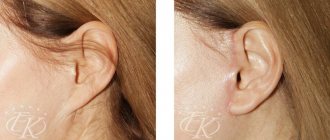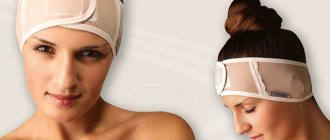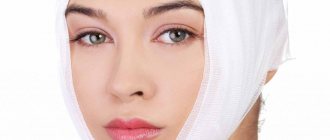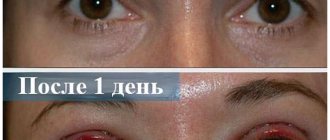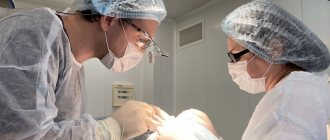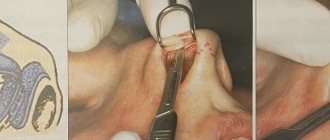Indications for otoplasty
Most often, cosmetic otoplasty is performed to correct protruding ears (protruding ears). This type of otoplasty involves changing the position/shape of the auricle by reducing the distance between the postauricular area and the posterior edge of the outer ear. Also indications for otoplasty are:
- asymmetry of the ears, differences in size and shape;
- large angle between the back of the head and the plane of the ear;
- too large/small earlobe;
- irregular shape of shells;
- acquired as a result of injury or congenital deformity;
- excessively large size of the ears, disturbing the overall proportions of the face;
- deformation of the earlobe due to wearing heavy jewelry, “plugs” and “tunnels”;
- absence of the outer ear/part of the auricle.
Rehabilitation after otoplasty
Photos before and after Reviews Videos Rehabilitation Prices Analyzes Questions and Answers
People who are satisfied with their own appearance in absolutely everything can be called lucky. But in most cases, we still want to change something, adjust something. And then we turn to a plastic surgeon for help.
Otoplasty (ear plastic surgery), or surgery to correct the shape and size of the ears, itself does not last long, on average about an hour, and is usually performed under local anesthesia. But the operation itself is not enough for a good result.
After otoplasty is performed, the patient is transferred to a ward where he will spend some time and then go home. If desired, the patient can stay one night in the hospital. This is necessary to monitor the patient and give him further recommendations.
Immediately after ear plastic surgery, the plastic surgeon applies a special bandage to the patient : it presses the new ears and, at the same time, protects them from mechanical damage. In addition, this dressing holds mineral oil-impregnated cotton wool, which helps to avoid post-operative swelling.
Usually, after otoplasty, various medications to speed up the healing process; the ears are sealed over the sutures with a special plaster , which prevents dirt from entering. And to protect the new ears from various injuries and mechanical damage, a tennis tape or scarf is put on the head .
During the first three days after otoplasty, you may be bothered by discomfort in the ear area; analgesics will help reduce them, but antibiotics prescribed by your doctor will need to be taken for at least five to seven days without fail.
The first dressing after ear surgery is performed the next day after surgery. The second dressing is prescribed on the 3-4th day after surgery. A week after ear surgery, you need to come to the clinic to have the stitches removed .
As with any plastic surgery, otoplasty will cause bruising and post-operative swelling . The bruises are not very visible and will take one week to disappear; they usually disappear by the time the stitches are removed. The duration of swelling depends on individual characteristics. To reduce this period, you need to limit yourself to salty and spicy foods and hot drinks - all of this provokes swelling.
the result of otoplasty immediately after the operation. The final result of otoplasty is assessed after two months , provided that a number of necessary conditions are met .
- Depending on the degree of complexity of the operation, the bandage, which protects the ears from possible accidental injuries, can be removed after three days, but the most optimal period of wearing the bandage is a week.
- Until the stitches heal, you should stop washing your hair.
- Due to pain and the danger of damaging the stitches, you should sleep on your back for the first time.
- During the first month, you need to wear a special bandage at night, it can be a tennis bandage, or buy a special bandage after otoplasty, so as not to cause damage due to awkward movements of the head or arms during sleep.
- Compared to other plastic surgeries, otoplasty is considered easy in terms of the rehabilitation period; however, you should limit yourself from physical activity and other activities that can lead to an increase in blood pressure, and also protect your ears from injury for two months.
- We also put off glasses for a month and a half.
After plastic surgery to correct the ears, the same physiotherapeutic procedures are used as rehabilitation as for other plastic surgery. This may include hardware cosmetology and other manipulations aimed at making healing faster and without complications.
Photos before and after otoplasty see other photos
There are a number of minor issues that you may encounter after otoplasty . For example, the skin of your new ears may become less sensitive. Be prepared for the fact that the return of sensitivity may be accompanied by “strange sensations”, like “goosebumps”. Soon everything will be restored and sensitivity will be as before.
Before plastic surgery of the ears, every plastic surgeon explains to his patient that plastic surgery on the ears does not in any way affect hearing . Unpleasant sensations in the postoperative period are absolutely natural. But you need to be patient, and soon you will appreciate the result of otoplasty and will rejoice at your perfect ears, on which not a trace of the operation will remain.
How is otoplasty performed?
Before the operation, antiseptic treatment of the correction area is carried out. Depending on the indications, otoplasty can be performed under general anesthesia or local anesthesia with sedation. When correcting protruding ears, the surgeon removes a section of skin on the back surface of the auricle and (if necessary) part of the cartilage tissue, fixing it in a new position to give the ear a more aesthetic and natural shape. Incisions are made in the natural folds of the posterior surface of the auricle. Then the surgeon applies stitches and a special fixing bandage is put on the patient’s head.
Kinds
There are 2 types of compression bandages for the ears after otoplasty.
- Open. This method of fixation ensures ease of hygienic treatment and preserves the range of head movements. The fabric is light and allows air to pass freely.
- Mask. Velcro straps around the neck help keep the bandage in place. Recommended to be worn while sleeping for protection. Cons - dense material does not allow air to penetrate. It is hot to wear a mask in the summer.
Rehabilitation period after otoplasty
The full rehabilitation period takes on average 1 month, but this figure may vary depending on the indications, the general health of the patient and the scope of the intervention performed. For several weeks after the operation, tissue swelling and bruising are observed, which are a normal reaction of the body to the correction and go away without additional restorative measures. In most cases, after surgery it is necessary to perform 2–4 dressings. Seams need to be treated regularly. 3 days after the operation, you can carefully wash your hair, avoiding unnecessary mechanical impact on the ears. Until complete recovery, it is prohibited to visit baths, saunas and solariums.
Bandage after otoplasty
Whatever the otoplasty technique, wearing a compression bandage after surgery is usually recommended.
However, the need for a postoperative dressing after surgery is controversial, and many plastic surgeons strongly argue against its use.
The benefits of wearing a compression bandage are:
Prevention of hematoma formation, reduction of postoperative bleeding and absorption of leaking blood.
Hematoma is one of the most terrible complications at the early stage of the postoperative period. This complication is usually caused by insufficient intraoperative hemostasis or other errors in surgical technique.
Less commonly, recurrent vasodilation from local anesthetics, hypertension, preexisting coagulopathy, and postoperative trauma may occur.
There is no evidence to support the notion that an otoplasty dressing serves a hemostatic role, and some believe that it cannot be tied tightly enough to prevent hematoma formation without causing a pressure ulcer on the forehead or pinna.
Studies have not shown an increase in the incidence of hematomas in the absence of a compression bandage.
Postoperative bleeding is a warning of a possible hematoma. Indeed, both have the same etiology. Again, as a general surgical principle, it should be noted that early postoperative bleeding is prevented by careful intraoperative hemostasis and not by dressings.
Bleeding is considered significant if it requires dressing changes. Studies that did not use dressings after otoplasty did not report a comparatively higher incidence of significant postoperative bleeding.
Splinting and formation of a new shape of the auricle.
After the studies, some doubts arose regarding the fact that a compression bandage after otoplasty helps to maintain the auricle in its formed position.
It is known that after a week the wound strength is still minimal and healing takes at least 6 weeks. If the bandage is used as a splint, it should be worn for up to 6 weeks.
Protecting the ear from possible injuries in the immediate postoperative period.
A removable elastic bandage should be used at night for 3–8 weeks to prevent the ear from accidentally folding during sleep.
Types of dressings after otoplasty
The type of headband used depends on the preference of the plastic surgeon. This may be a supportive bandage made of loose gauze, or an ear bandage made of silicone foam with a protector, or a bandage made of a self-fixing bandage, or a special bandage with Velcro.
The presence of different types of dressings indicates that no single universal type of such dressings has been found. Some of them are significantly complex and quite difficult to apply or remove and reapply if necessary, and some are uncomfortable to wear at night and in hot weather.
On the other hand, some can easily slip off and allow the ear to fold into an unfavorable position during sleep.
Duration of wearing a bandage after ear surgery
In long-term studies, it was found that early removal of the bandage did not jeopardize the outcome of the operation. The duration of head bandage application varies from a few hours to 10 days, in some cases even 2 weeks after surgery, followed by a period of overnight protection for 3-4 weeks.
Possible problems and complications due to wearing a bandage
The use of a headband itself can lead to many complications:
- Slipping of the bandage and frequent need for dressing.
This is the most common problem (40 to 67% within a week after surgery), and in many cases the bandage can migrate, causing unexpected tension in the ear.
And this, in turn, can cause trouble, leading to repeated visits to the clinic, inconvenience and malaise.
- Excessive pressure can lead to necrosis of the skin of the anterior surface of the auricle and the skin of the forehead.
This may result from disruption of the venous circulation in the subcutaneous plexus caused by excessive pressure due to an inappropriately tight bandage. Necrosis can also occur as a result of hematoma expansion or infection, as well as technical errors such as excessive diathermy.
- Inability to early recognize complications such as infection and hematoma.
- Temporary hearing loss due to cotton wool filling the ear, blocking the external auditory canal.
- Postoperative nausea and vomiting from the pressure of the bandage on the auricles as a result of stimulation of the branch of the vagus nerve innervating the auricle and the posterior wall of the external auditory canal.
- Discomfort and itching due to sweating.
But whatever the possible complications of wearing a compression bandage on the ears, the benefits outweigh the disadvantages.
In any case, follow your plastic surgeon's recommendations in the postoperative period, including wearing a bandage.
Effect of otoplasty
The effect of the operation lasts for life. Otoplasty allows you to achieve proportionality of both the ears themselves and the overall appearance, eliminating aesthetic imperfections that have arisen as a result of injuries or are a congenital feature.
Questions and answers
At what age can otoplasty be performed?
Otoplasty can be performed from the age of 5, since this age coincides with the final stage of the formation of the auricle.
Are there any traces left after otoplasty?
No, all incisions and postoperative scars are located in the natural folds of the auricle on its back surface and are not noticeable from the outside.
How long to wear a bandage after otoplasty
- Immediately after the procedure, the wound is bandaged.
- A day later, the surgical wound is examined and treated. A second dressing is performed.
- By removing the stitches at the beginning of the second week, the compression material is changed to elastic.
- Subsequently, it is recommended to wear a bandage after otoplasty. It is worn during sleep for a month. Silver-treated fabric accelerates recovery and protects against inflammation.
The question of how long to wear a bandage after otoplasty is decided individually. This will depend on the speed of tissue healing and the condition of the body. The patient spends approximately a month in a bandage.

